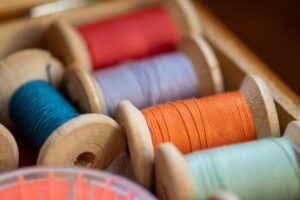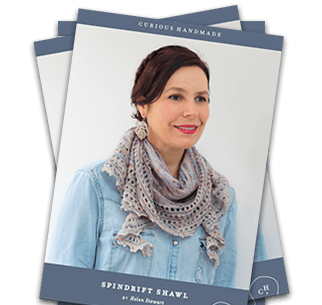This is our second guide in my series of sock knitting advice. I know there are a lot of veteran sock knitters in the Curious Crew, but I also remember how intimidated I was by the idea of knitting socks before I got my first one on the needles. As always, I love encouraging knitters to stretch and learn new skills! My hope is that with the help of these tutorials and resources, everyone who wants to try their hand at socks will feel confident and excited to begin.
Once you’ve chosen your pattern and your perfect yarn, the next step in sock knitting is to decide what type of needles you are going to use to knit your socks. Knitting a small diameter tube like a sock means knitting in the round, and there are two main ways to achieve this feat:
Magic Loop
It sounds very mysterious, but Magic Loop is actually a very simple way to knit socks. Using a long circular needle which is pulled back and forth as you knit, it allows you to knit in any small diameter. Craftsy has an excellent free tutorial on Magic Loop here. If you want to deep-dive into the subject, they also have a “Knit Smarter with Magic Loop” course taught by Lorilee Beltman (currently on sale)!
I love Magic Loop because I Iove just having one type of needles (ie circular) for all my projects and because it’s so portable. Magic Loop socks are the ultimate travel knitting, because you can move all you stitches to the cord for safekeeping and not worry about any slipping off in your bag.
Some people even knit two socks at a time using the Magic Loop Method! My friend Mina of The Knitting Expat podcast, has a brilliant episode on this technique.
You can knit Magic Loop on any circular needle, as long as the cord is long enough: 32″ or 80 cm is most popular, though if you’re doing two socks at once you may want to go up to 40″ or 100 cm. You want a circular needle with a flexible cord and smooth joins. If you can afford it and are planning to knit a lot of socks, this is somewhere that investing in high quality needles can really pay off. Using less expensive or stiffer needles, you may find it difficult to move the stitches back and forth, which can be frustrating.
Newer on the market are 9 inch Circular Needles such as these Clover Takumi Bamboo Circular needles where you don’t need to do Magic Loop, you simply knit around and around. They have a short cord and short needles. Some people love them because they are faster because you can simply keep going around and the fabric is more consistent. Some people don’t love them because they feel too small to hold comfortably and they can also be harder to find in shops.
Double Pointed Needles (DPNs)
While Magic Loop is considered the sock-knitting standard by many, a lot of knitters prefer using double pointed needles for socks. The triangular shape created by three DPNs holding stitches as you knit has a lot of fans. Some people prefer the rhythm they achieve knitting with DPNs, without having to move the loop around. For others, it’s a matter of time-honoured tradition!
DPNs can look a little scary if you haven’t knit with them before: all those needles, all those ends…is that a knitting project or a hedgehog? While working with DPNs for the first time can feel a little fiddly, it’s really much more simple than it appears. You can also look at the process step by step in this free article from Craftsy and again, if you want to get really confident about double pointed needles before THSS begins, there’s a Craftsy class from sock expert Ann Budd called “Essential Skills for Sock Knitting” that includes a section on DPNs and lots of other sock knitting tips.
DPNs are available in a wide range of materials, from wood to metal and plastic. Wood needles tend to be a little more “grippy” or “slow” than super smooth metal needles. If this is your first DPN project, you might find it easier to keep all your stitches where you want them on wooden needles.
Two Sets of Circulars
When I sent out the email version of this guide, two very helpful members of the Curious Crew wrote to me to remind me of another great way to knit socks: using two sets of circular needles. Some people find this message easier than Magic Loop and gentler on their hands than DPNs. The recommended length for circular needles using this method is 24″or 60 cm. This tutorial at The Spruce has great pictures and lots of advice on mastering this technique, and there is also a very clear video here on Youtube where Amy Detjen walks you through circular knitting using two circular needles!
I write my patterns for the Magic Loop method, because it’s my personal favourite. You can convert a pattern written for Magic Loop to DPNs and vice versa, usually without too much trouble. If you do want to use DPNs instead, you’ll just need to divide the stitches evenly among your needles. If you’re using 4 needles, your double pointed needles 1 & 2 will be the “Needle One” referred to in the pattern, while needles 3 & 4 will be “Needle Two” in the pattern.
Just for reference, switching a pattern written for DPNs to Magic Loop is even easier: just pop all the stitches onto the loop and use stitch markers to mark where each DPN would begin or end.
I hope you’ve found this overview of sock needles helpful! Whenever I’m trying to master a new technique, these kinds of resources make it all so much easier. My wish is that these guides will do the same for you.





